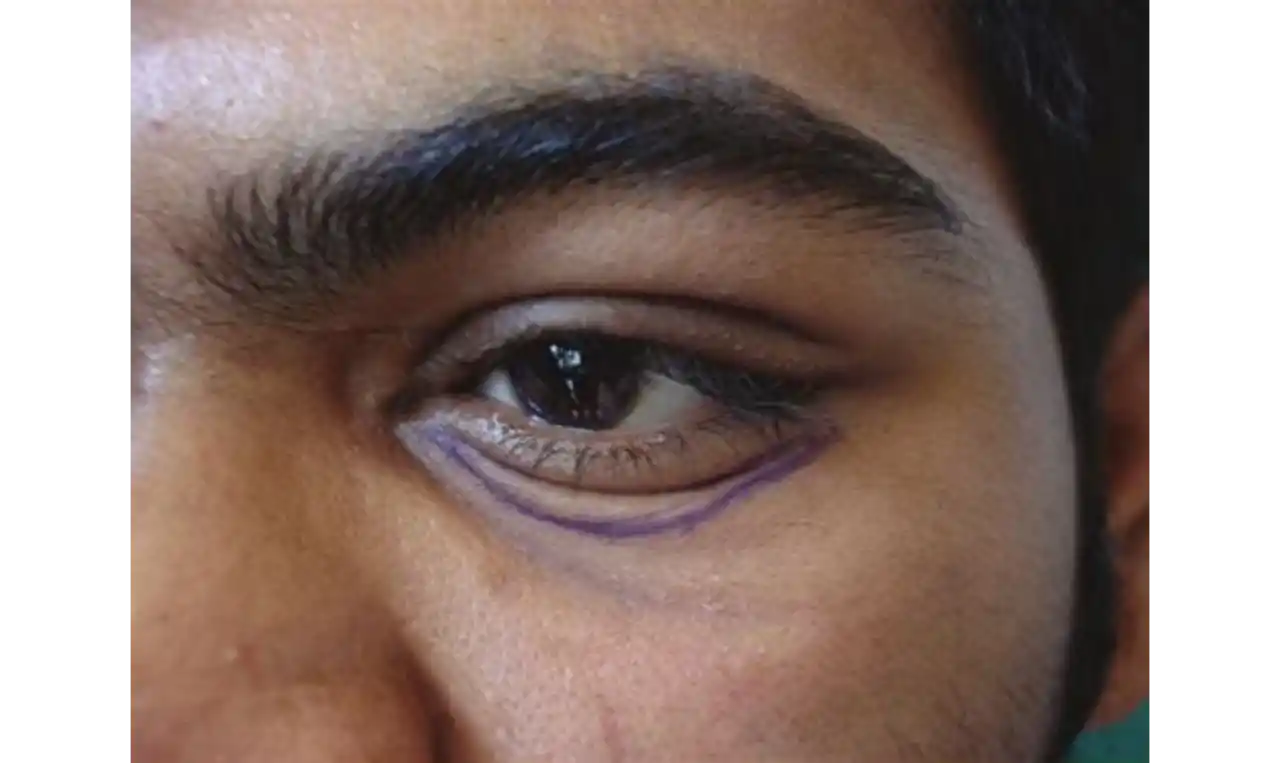
What is Blepharochalasis ?
Blepharochalasis is a rare disorder that typically affects upper lids. It is characterised by intermittent oedema of the lids, with frequent recurrence. It produces eyelid tissue relaxation and latter atrophy. It may be unilateral in some cases. In addition to recurrent attacks of oedema, it is associated with ‘cigarette-paper’ skin and subcutaneous telangiectasia.
The term blepharochalasis was coined by Fuchs in1896. The term blepharochalasis is frequently misused to indicate redundant skin of the ageing eyelid, a common condition more accurately termed as dermatochalasis.
The word blepharochalasis originates from the Greek word blepharon meaning eyelid and chalasis meaning relaxing.
References
Blepharochalasis Symptoms
Patient may present with symptoms like
- Unilateral or bilateral transient painless swelling of the eyelids.
- Unilateral or bilateral swelling of the conjunctiva.
- Proptosis (bulging of the eyeball).
- Prolapse of lacrimal gland.
- Presence of pads of fat due to atrophy of the orbital septum and skin.
- Deep superior sulcus due to fat atrophy.
- Thin atrophic bronze coloured eyelid skin which resembles parchment (thin, flat and stiff) due to atrophy of fat.
- Multiple fine telangiectatic vessels.
- Blepharoptosis (drooping of eyelid) due to thinning and atrophy of aponeurosis of levator palpebrae superioris muscle.
- Horizontal blepharophimosis and rounding of lateral canthus due to dehiscence of lateral canthal tendon.
- Ectropion.
- Pseudoepicanthal folds.
Eyelid changes are exacerbated by normal process of ageing.
Occasionally, attacks are aggravated by a triggering event such as fever, weeping, upper respiratory tract infection.
Blepharochalasis Causes
Blepharophimosis may be a form of chronic angioedema with localised vascular dilatation and extravasation of proteinaceous fluid. Orbital fat may have increased vascularity and dilated capillaries.
Triggers:
Multiple triggers may be the factors including
- Immune reactions.
- Environmental factors.
Pathogenesis
Pathogenesis is uncertain, but this condition may be immunogenic in origin. There is abundance of IgA deposits around elastin fibers. Infrequently there may be familial occurrence (autosomal dominant inheritance).
Associations
Sometimes blepharochalasis is associated with systemic illnesses such as
- Amyloidosis.
- Dermatomyositis.
- Leukaemia.
- Laffer-Ascher syndrome showing oedema of lips and thyroid enlargement.
- Melkersson-Rosenthal syndrome (triad of recurrent labial oedema, relapsing facial paralysis and fissured tongue) may present with eyelid oedema of unknown cause.
Rarely, blepharochalasis may be associated with agenesis of the kidney, vertebral abnormalities, and congenital heart defects.
Pathology
Pathology typically shows loss of elastic fibers, Lymphoedema, vasculitis and epithelial atrophy. Stretching of the aponeurotic fibers of levator palpebrae superioris muscle due to recurrent low grade inflammation produces aponeurotic ptosis (drooping) of the lids.
Blepharochalasis Diagnosis
Diagnosis depends upon history of disease and clinical examination. There are no characteristic laboratory findings.
I. History:
Patient gives history of repeated episodes of painless swelling of one or both eyelids with subsequent thinning of skin, usually affecting people between the ages of 10-20 years. Oedema is initially seen frequently in upper lids. The frequency of attacks is variable. It may be associated with a preceding period of physical or emotional stress. Occasionally, there may be history of allergy.
II. Clinical features:
Patient shows clinical features such as lid or conjunctival oedema, proptosis, ptosis, telangiectasia of vessels, ectropion, entropion, skin parchment, or pseudoepicanthal folds. The skin hangs down over the upper eyelid.
The disease may be separated into
A. Early phase
It may be further divided as
- Hypertrophic form.
- Atrophic form.
B. Late phase.
Differential diagnosis
- Angioedema: Usually older age of onset. Oedema is widespread and is not limited to the upper lid. There is an association with complement 1-esterase inhibitor deficiency and auto-antibodies.
- Dermatochalasis: It is a common ageing process with redundant skin and fat prolapse.
- Floppy eyelid syndrome: It is typically found in older, obese men. There is an association with papillary conjunctivitis.
- Idiopathic lymphoedema: There is unremitting brawny oedema (swelling of subcutaneous tissue that cannot be indented easily), seen usually in older patients.
- Tumour: It presents as progressively enlarging mass. Biopsy may be needed for the diagnosis.
- Drug induced urticaria.
Blepharochalasis Complications
Complications and sequelaes may be
- Conjunctival oedema.
- Entropion.
- Ectropion.
- Conjunctival redness.
- Steatoblepharon (sagging of eyelid tissues due to proplapse of fat below the eyelid).
- Ptosis.
- Excessively thin skin (cigarette-paper skin).
